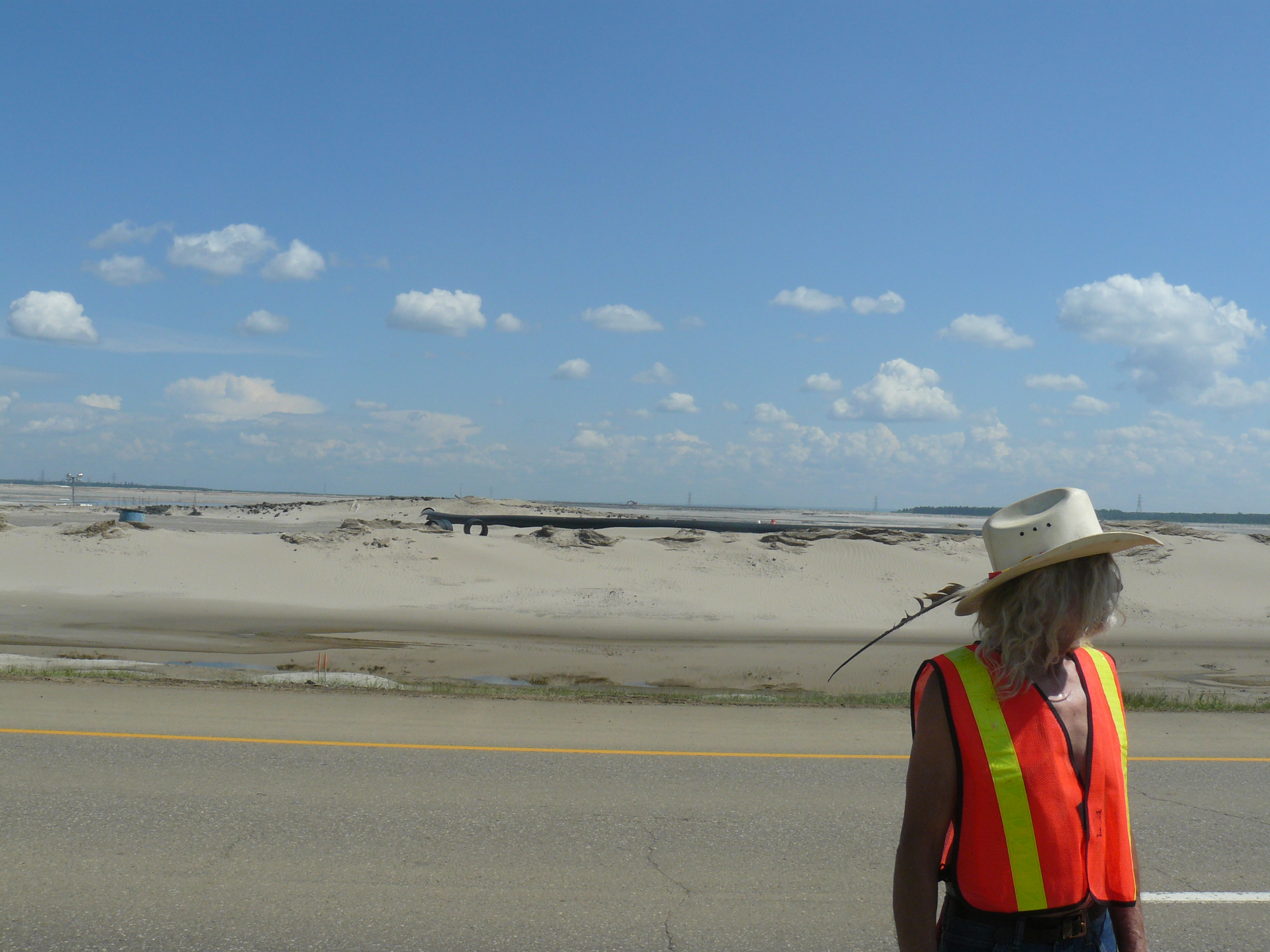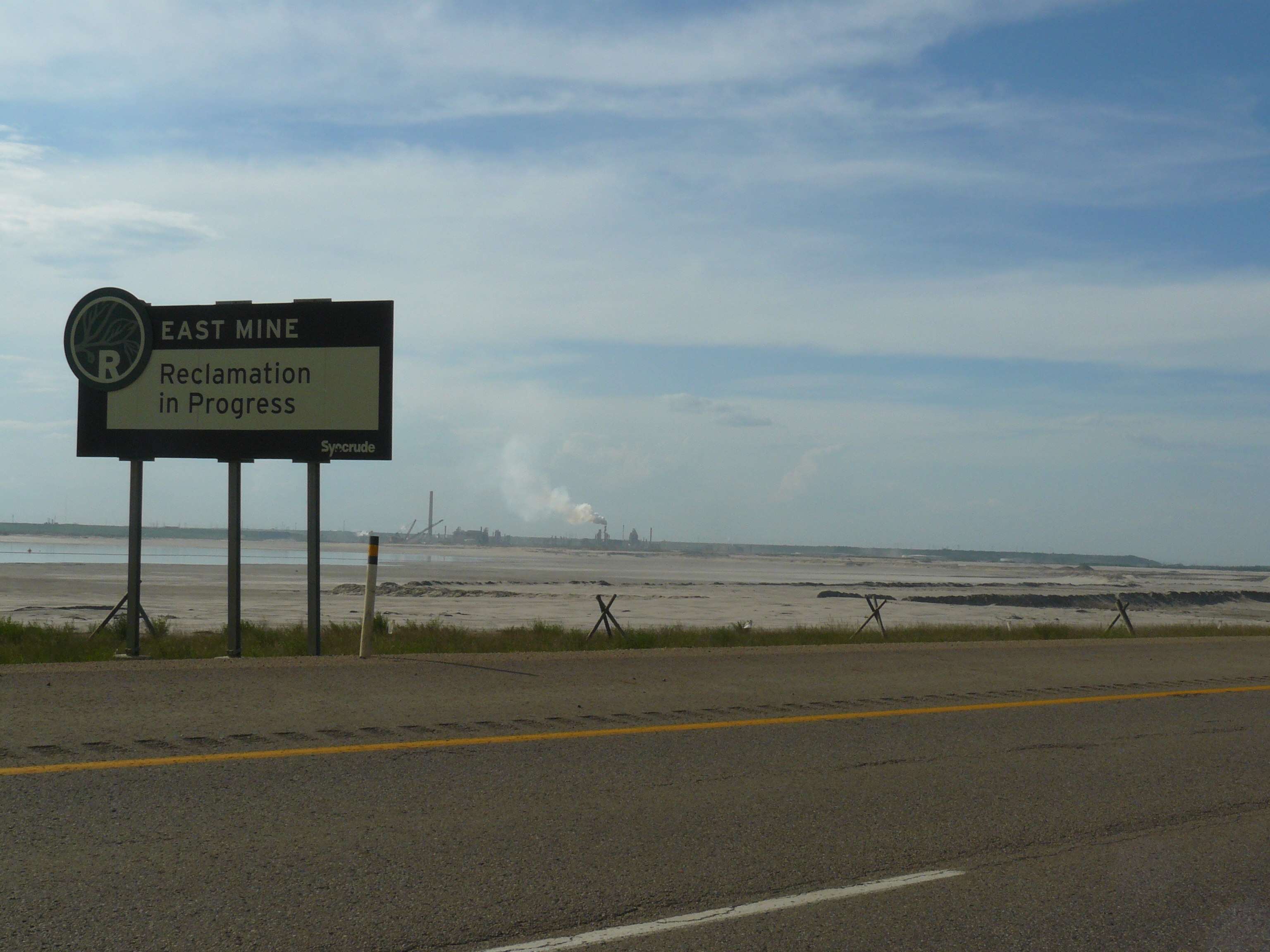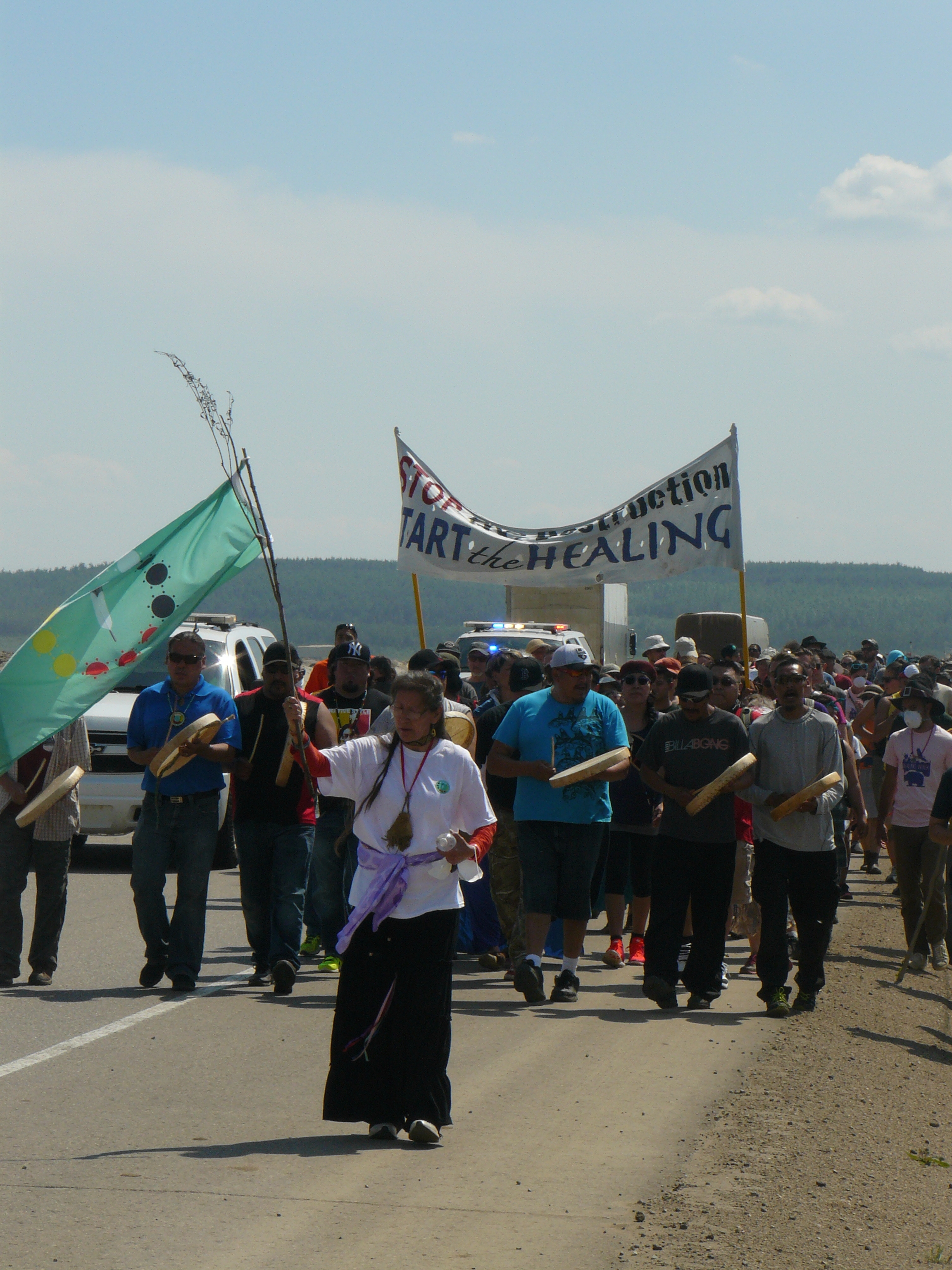It’s the last week of our supporter drive and boy, do we need you! Please help rabble.ca amplify democratic movements like the struggle against the Tar Sands. Become a monthly supporter.
The fifth and final Athabasca Tar Sands Healing Walk took place June 27 – 29, 2014 near Fort McMurray, Alberta.rabble.ca‘s Blogs Coordinator, Michael Stewart, attended to participate in, learn from and bear witness to this powerful event. The following is the third and final instalment of a series recording his experiences. Read his preamble in advance of the Walk here. Part one can be found here, part two here.
The morning of the fifth and final Tar Sands Healing Walk promised to be hot. While we waited for the busses that would transport us from Indian Beach to the Syncrude and Suncor development sites for the 16 km walk, my companions snatched at whatever pocket of shade they could find while we applied sunscreen, filled our water bottles and passed out dust masks.
The 45-minute drive to the start of the walk passed through Fort McMurray, giving me a chance to revisit the boomtown I hadn’t seen since landing. It’s hard to describe the extent to which the oil industry saturates every aspect of the city. The Airport Nicholby’s sells prominently displayed T-shirts with the Canadian maple leaf and “OIL SANDS” written on the front, yoking your workplace to some measure of national pride. The heavy-machine mechanic that sat next to me on the plane, coming back after an extended 18-day furlough to see his family in Nanaimo, had luggage provided by Suncor — as did many of my fellow passengers. Usually he and his co-workers work six days on, six days off — and the direct flights available from Fort McMurray are telling. With new billboards that cajole “What leaves Fort Mac stays in Vegas,” there isn’t much subtlety as to what tar sands workers are encouraged to do with their boomtown payoff.
The busses pass by the “Oil Sands Discovery Centre,” a museum-cum-propaganda site provided by the Government of Alberta. Admission is seven dollars to learn about the history and science of bitumen extraction, replete with enormous relics of the machinery once used in former mining practices.
Without a doubt, the technological might on display in the Tar Sands is truly awesome. Heavy hauler trucks boast tires wider than a buffalo and wheel wells that could house a full-grown human. Cold-War era fixtures dot the horizon — from refineries with smokestacks that would make Charles Dickens blush to old bucket-wheel excavators that were literally used to provide the fiendish backdrop to James Cameron’s Avatar. The bucket wheel itself is roughly seven stories high and resembles a gargantuan buzz-saw blade; its purpose, to strip away a section of the earth and hoist the cuttings up a massive converyored boom where it is discharged for storage and processing.

Allegedly more-efficient trucks have mostly replaced these post-apocalyptic machines, but you can still see mothballed specimens here at the Discovery Centre — or, as we would later discover, on the site of the Syncrude East Mine, which also, incredibly, offers overnight camping for the brave or foolhardy.
NO FISHING IS PERMITTED FOR YOUR SAFTEY
We arrived at the start of the Walk and I hope it’s not too clichéd to note that the air sat heavy, close with the sweet smell of chemicals and petroleum — its commonly referred to as the “smell of money.” The blasts from the sound cannons were louder and very much in attendance.
We gathered just outside the Crane Lake Nature Trail, an area supposedly reclaimed by Suncor after a few decades of mining. An imposing sign puts paid to this claim with the admonition: “NO DIVING, NO SWIMMING, NO WADING, NO FISHING IS PERMITTED FOR YOUR SAFETY.” So not quite reclaimed yet, it seems. To show their sense of irony remains well exercised, Suncor also warns “PLEASE DO NOT DISTURB THE ECO SYSTEM.” Well, that’s one of us.
All the sites we surveyed also sport an impressive number of “No Trespassing” signs. These cautions are surely part of Syncrude’s due diligence to keep out curious onlookers and avoid unpleasant lawsuits — but also as a warning to activists like the 37 Greenpeace members (at least one of whom, Mike Hudema, was with us on the Walk) who occupied a Suncor plant in 2009. Of course, to the Aboriginal contingent of the Healing Walk whose ancestors have lived off the lands now under duress from tar sands expansion, these signs could invite a cynical smile — especially in light of the previous day’s Tsilhqot’in decision. It’s not us, Syncrude, doing the trespassing.
The organizers gathered us in a circle to share water, corn, meat and berries in a ceremony to bless the walk. Nancy Scanie, an Elder from Cold Lake First Nation — who completed the grueling walk in a sharp-looking blazer and moccasins — told us that she had prayed for us. “May you all be light of foot,” she said. “For the children we’ve never seen.”
Grand Chief Nepinak, who had given one of the keynotes and lead the pipe ceremony every morning, cut a forceful and imposing figure with his ceremonial headdress, black t-shirt and jeans. Earlier, during his keynote, he called himself “the Residential School rebuttal. I am the complete opposite of everything they tried to do to my mother.” Here, he reminded the crowd of the power of healing. “I stand here today with the time I’ve been given,” he said. “And I’m going to make a difference.”

Drums vs. duck cannons
We set off and the Walk was hot and dry, scorching your skin and your spirit. Heat emitting from tar sands machinery and apparatuses produce a microclimate affecting wind speed, humidity and, of course, temperature. Tailings ponds littered the vivisected landscapes amidst vast deserts of fine white sand — a dark parody of the earth and water that used to feed this land.
Up close, the duck cannons that had provided the soundtrack for most of the weekend were loud enough to startle. But much more disturbing were the bright orange scarecrows — known locally as “Bit-U-Men” — acting as a deterrent to local water fowl not sufficiently frightened by the incessant mortar blasts.
Thankfully, as respite the Dene drum circle that had travelled 17 hours from northern Manitoba to be here struck up a pounding rhythm and stirring song that did not cease for the entire six-hour Walk. Their chanting and drumming had kept many a camp up late into the evening, dancing around the fire with their hands to the heavens. Here, they kept morale up while unforgiving heat and raw environmental devastation threatened our humour.
Just past our first view of the tailings ponds the Syncrude Mildred Lake refinery and upgrader complex comes into view. My eyes begin to sting. The highway past the refinery has been overhauled and upgraded three times since the first Healing Walk five years ago. The most recent reconstruction raised the three-lane, one-way loop between the Suncor and Syncrude development sites six metres above now-imperceptible creek beds, as dusty and dry as a John Steinbeck setting.
The plant is a daunting example of 1970s industrial architecture and design, with liberal use of concrete and sloping curves of chrome pipes and shafts. It is literally a small town, comprised of mess kitchens and worker barracks that look dismal from the outside, evoking labour camps from the 1930s (perhaps with cause: a Facebook review of “Mildred Lake Village” mourns the fact she can’t give “negative stars”). Mildred Lake produces a high-quality type of crude that requires the extraction of sulphur — which, since the international market for sulphur became saturated, can’t be sold and must be stored in flat piles outside, with ambitions to become towering, bright yellow pyramids.

Getting to ‘no’
Whenever I could, I tried to talk to Fort Mac residents not involved with or unaware of the Healing Walk to get a sense of where climate change registered on the local radar. I couldn’t find anyone born in Fort Mac during my visit. One of the longest-serving residents, a server at the new airport pizza joint (already one of the most popular restaurants in town), had moved here from Ontario ten years ago. Most residents I spoke to averaged about one to three years. When asked about environmental concerns, most residents responded with bafflement or bemusement. “What do you mean?” was one response. The Fort McMurray-Athabasca Federal by-election took place the day after I left — all four candidates fully support the oil industry and the Conservative candidate still won in a walk.
One long-time Fort Mac resident I met on the Healing Walk itself, an administrative temp worker in the industry, moved from Prince George, B.C. almost eighteen years ago. She broaches the question of climate change and carcinogenic pollutants with her neighbours and colleagues whenever she can. “You have to learn to talk to people and get them to say ‘no,'” she told me. “‘Yes’ is easy, because when you get a ‘yes,’ it’s over. It’s getting a ‘no’ that’s hard.”
I asked her about the stereotypes perpetuated across Canada of Fort MacMurray and its residents. She was unequivocal: “It’s wrong.” All cities have problems with drugs, crime and an exploited labour force, she explains. She’s talked to many people and it’s their livelihood that remains their chief motivation. “I’ve never met one man who would say ‘I’ll miss this when it’s gone.'”
Reclamation in (endless) progress
The end of the walk was exhausting in every conceivable way — in heart, spirit and body. At some point, the monotony of desolate horizons ceased to shock and simply ground down your resolve through sheer attrition. Even the sign over the barren East Mine site we had just surveyed that claimed, audaciously, “Reclamation in progress” failed to earn more than a cynical shake of the head. Most of us slept soundly on the quiet bus ride back to camp, grateful for the opportunity to digest, meditate and reflect on the devastation to which we had just borne witness.
On arrival at Indian Beach, to a person we poured out of the busses, shed our clothing and plunged into Gregoire Lake — washing off the sweat and grit accumulated on our bodies, but also scrubbing off the taint of what we had seen in a symbolic ablution. The rest of the evening was a celebration: feasting, more drumming, dancing, urban rhymes, Métis jigs and soulful song. We stayed up late, watching the mayflies flit endlessly up and down, up and down — until the sun finally, finally went down.

* * *
The next morning, we departed after a subdued, though packed, pipe ceremony. We extinguished the central campfire with the water gathered from the home waters of all in attendance. We broke camp collectively, each of us helping where it was needed.
Everyone who has witnessed the Tar Sands first hand tells you that nothing can prepare you for what you will see. They’re right, of course; but this expectation of unreadiness never goes away, even after you observe what you’re meant, finally, to comprehend. Only five per cent of the tar sands have been prepared for resource extraction and we experienced only the faintest fraction of the Athabasca region under development during the healing walk. Not 70 kilometres from our campsite, Imperial Oil’s $12.9-billion open-pit Kearl mine will be one-and-a-half times the size of the City of Vancouver when it is completed. How many synonyms for “devastation” can one find before the exercise becomes futile?
What I in fact learned is that the physical and intellectual dimensions of the Tar Sands are ultimately unknowable — no amount of walks, fly overs, mappings or statistics can communicate them because their reach is too far, their sinews too deep. The petroleum industry subsumes everything from tar sands developments in Athabasca, Cold Lake, the Peace, and Saskatchewan; offshore drilling in the Maritimes and perhaps one day British Columbia; fracking in B.C., New Brunswick, Ontario and Quebec; pipelines like Northern Gateway, Line 9, Kinder Morgan, Energy East and more. How can this whirlwind be measured let alone understood?
The answer, if there is one, is in the way the local communities who organized and inspired this walk understand the Tar Sands: instinctively; all at once; in your bones and in your blood. As Healing Walk organizer Crystal Lameman told us during a workshop, “I don’t have time to be stubborn because my people are dying.”
What matters, always, is when the healing can start.
* * *
As my plane from Fort McMurray International gains altitude, the land beneath fades away and I can see the seismic cuts criss-cross the Boreal Forest that used to grow uninterrupted from the coast of the Labrador Sea to the foothills of the Rocky Mountains.
I can’t hear them now, but I know that the blasts of the sound cannons continue to carry through the heavy air their distant, lilting thunder.
Read Part One of “Healing a Boomtown” here. Part two, “Water, water everywhere and not a drop to drink” can be found here.
All photos by Michael Stewart.



